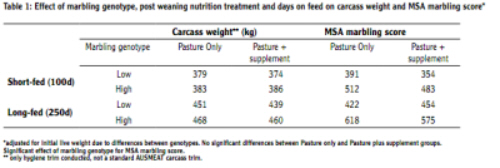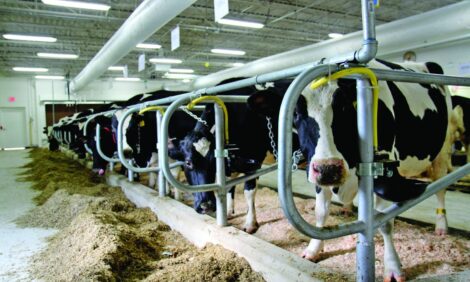



Strategies To Achieve High Marbling
A recent Beef CRC project led by Dr Paul Greenwood, Principal Research Scientist at New South Wales Primary Industries, has sought to determine if it is possible to increase marbling through the strategic use of high energy supplements immediately post-weaning.Marbling score is one of the main specifications for high value export markets such as the Japanese B3.
Marbling is the small flecks of fat visible to the human eye. Increased marbling is associated with improved eating quality through juiciness and flavour.
There are three main types of fat depots in beef cattle carcases; these include subcutaneous fat, for example rib and rump fat, intra-muscular fat (marbling) and inter-muscular fat which is positioned between muscles.
Subcutaneous fat is sometimes referred to as “waste” fat and intramuscular fat as “taste” fat. Producers are challenged with having adequate fat to allow animals to function normally and meet market specifications (e.g. minimum P8 of 6mm) whilst minimising waste fat.
At both the farm level and industry level excessive fat is undesirable. It is associated with an inefficient use of energy and costs processors in trimming.
High energy supplements post weaning
A recent Beef CRC project led by Dr Paul Greenwood, Principal Research Scientist at NSW Primary Industries, sought to determine if it was possible to increase marbling through the strategic use of high energy supplements immediately post-weaning.
The project also investigated MSA marbling score differences between steers bred from sires that were either high or low for genetic propensity to marble.
In total, there were 168 steers involved in the project. They were weaned at an average of six months. From weaning until 12 months old, half of the steers were fed pasture whilst the rest of the steers received pasture in conjunction with a high energy pellet supplement.
During the nutritional period, the pasture available to the cattle was managed so that cattle growth rates were the same for both nutrition treatments. Steers were then backgrounded until feedlot entry at 18 months of age where they were then either short or long feedlot fed for 100 and 250 days, respectively.
The use of a high energy supplement during the immediate post-weaning period did not enhance marbling in either the genetically high or low marbling steers.
Longer time in the feedlot (100 days vs. 250 days) was associated with increased marbling for all groups.
After 100 days on feed, the high marbling genotype steers had an average MSA marbling score more than 100 points higher than the low marbling genotype steers (Table 1). After 250 days on feed, the high marbling genotype steers had an average MSA marbling score of 618 compared with 422 for the low marbling genotype steers.

Project outcomes
If producers are trying to increase the amount of marbling within their beef carcases as assessed by MSA marbling score, the results from this project demonstrate the importance of selecting cattle with a high genetic capacity to marble using intramuscular fat estimated breeding values (IMF EBVs).
Previous research has shown the best nutritional and/or management tool for increasing marbling is to finish cattle on a highly digestible, grain-based diet. This provides the highest level of net energy leading to high blood glucose levels and promotes fat deposition.
Breeding or buying steers with a high genetic capacity to marble and providing them high quality improved pastures post-weaning and during backgrounding is the most efficient way of ensuring feeder steers will reach maximum marbling potential.
If post-weaning supplementation is required to meet market specifications, balance the diet for both protein and energy rather than energy alone.


